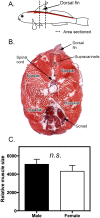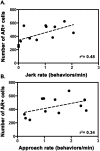Sex differences in neuromuscular androgen receptor expression and sociosexual behavior in a sex changing fish
- PMID: 28520775
- PMCID: PMC5433761
- DOI: 10.1371/journal.pone.0177711
Sex differences in neuromuscular androgen receptor expression and sociosexual behavior in a sex changing fish
Abstract
Androgen signaling, via receptor binding, is critical for regulating the physiological and morphological foundations of male-typical reproductive behavior in vertebrates. Muscles essential for male courtship behavior and copulation are highly sensitive to androgens. Differences in the distribution and density of the androgen receptor (AR) are important for maintaining dimorphic musculature and thus may provide for anatomical identification of sexually selected traits. In Lythrypnus dalli, a bi-directional hermaphroditic teleost fish, both sexes produce agonistic approach displays, but reproductive behavior is sexually dimorphic. The male-specific courtship behavior is characterized by rapid jerky movements (involving dorsal fin erection) towards a female or around their nest. Activation of the supracarinalis muscle is involved in dorsal fin contributions to both agonistic and sociosexual behavior in other fishes, suggesting that differences in goby sexual behavior may be reflected in sexual dimorphism in AR signaling in this muscle. We examined sex differences in the local distribution of AR in supracarinalis muscle and spinal cord. Our results demonstrate that males do express more AR in the supracarinalis muscle relative to females, but there was no sex difference in the number of spinal motoneurons expressing AR. Interestingly, AR expression in the supracarinalis muscle was also related to rates of sociosexual behavior in males, providing evidence that sexual selection may influence muscle androgenic sensitivity to enhance display vigor. Sex differences in the distribution and number of cells expressing AR in the supracarinalis muscle may underlie the expression of dimorphic behaviors in L. dalli.
Conflict of interest statement
Figures




Similar articles
-
Androgen receptors and muscle: a key mechanism underlying life history trade-offs.J Comp Physiol A Neuroethol Sens Neural Behav Physiol. 2018 Jan;204(1):51-60. doi: 10.1007/s00359-017-1222-4. Epub 2017 Oct 23. J Comp Physiol A Neuroethol Sens Neural Behav Physiol. 2018. PMID: 29063284 Review.
-
Ancestral androgenic differentiation pathways are repurposed during the evolution of adult sexual plasticity.Evol Dev. 2016 Dec;18(5-6):285-296. doi: 10.1111/ede.12207. Evol Dev. 2016. PMID: 27870212
-
Spinal motor and sensory neurons are androgen targets in an acrobatic bird.Endocrinology. 2012 Aug;153(8):3780-91. doi: 10.1210/en.2012-1313. Epub 2012 May 25. Endocrinology. 2012. PMID: 22635677 Free PMC article.
-
Ontogeny of androgen receptor immunoreactivity in lumbar motoneurons and in the sexually dimorphic levator ani muscle of male rats.J Comp Neurol. 1997 Mar 3;379(1):88-98. J Comp Neurol. 1997. PMID: 9057114
-
Hormones and the neuromuscular control of courtship in the golden-collared manakin (Manacus vitellinus).Front Neuroendocrinol. 2013 Aug;34(3):143-56. doi: 10.1016/j.yfrne.2013.04.001. Epub 2013 Apr 25. Front Neuroendocrinol. 2013. PMID: 23624091 Free PMC article. Review.
Cited by
-
Preparing to migrate: expression of androgen signaling molecules and insulin-like growth factor-1 in skeletal muscles of Gambel's white-crowned sparrows.J Comp Physiol A Neuroethol Sens Neural Behav Physiol. 2019 Feb;205(1):113-123. doi: 10.1007/s00359-018-1308-7. Epub 2018 Dec 8. J Comp Physiol A Neuroethol Sens Neural Behav Physiol. 2019. PMID: 30535830
-
Testosterone levels positively linked to muscle mass but not strength in adult males aged 20-59 years: a cross-sectional study.Front Physiol. 2025 Apr 15;16:1512268. doi: 10.3389/fphys.2025.1512268. eCollection 2025. Front Physiol. 2025. PMID: 40303597 Free PMC article.
-
Seasonal regulation of behaviour: what role do hormone receptors play?Proc Biol Sci. 2020 Jul 8;287(1930):20200722. doi: 10.1098/rspb.2020.0722. Epub 2020 Jul 8. Proc Biol Sci. 2020. PMID: 32635860 Free PMC article.
-
Sex Steroids as Regulators of Gestural Communication.Endocrinology. 2020 Jul 1;161(7):bqaa064. doi: 10.1210/endocr/bqaa064. Endocrinology. 2020. PMID: 32307535 Free PMC article. Review.
-
Species variation in steroid hormone-related gene expression contributes to species diversity in sexually dimorphic communication in electric fishes.Horm Behav. 2024 Aug;164:105576. doi: 10.1016/j.yhbeh.2024.105576. Epub 2024 Jun 8. Horm Behav. 2024. PMID: 38852479 Free PMC article.
References
MeSH terms
Substances
LinkOut - more resources
Full Text Sources
Other Literature Sources
Research Materials

